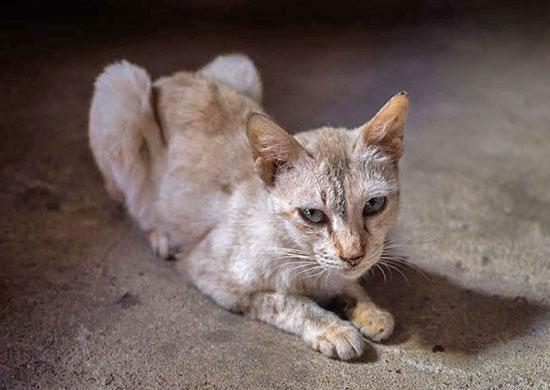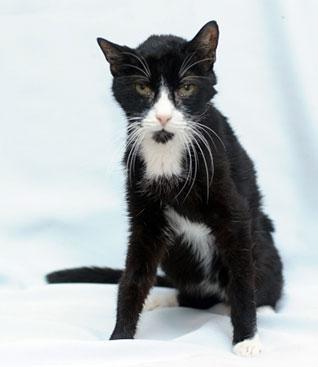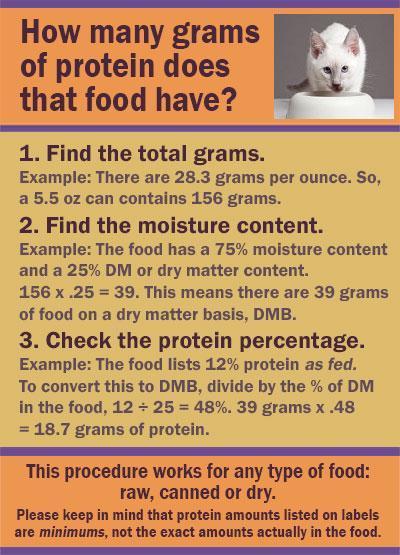This content is archived from the Feline Nutrition Foundation
Don't Let Your Senior Cat Become a Skinny Old Kitty
- Updated: Thursday, May 02, 2019 04:16 PM
- Published: Saturday, April 25, 2015 03:33 PM
- Written by Mark E. Peterson, DVM, Dip. ACVIM
 I've received a number of inquiries both from veterinarians and cat owners asking about the daily protein requirements for cats. How about protein requirements for clinically normal geriatric or senior cats with a nonthyroidal illness? These are excellent questions, given the fact that all cats will need higher amounts of protein as they age to prevent a loss in lean body mass and associated muscle wasting. The dogma that all older cats be fed reduced energy "senior" diets must be questioned based on what is now known about the increasing energy requirements and nutritional needs of older cats.¹⁻² The higher maintenance energy requirements of geriatric cats, in combination with their impaired ability to digest protein, will lead to loss of muscle mass if their overall energy and protein needs are not met.¹⁻⁵ In addition to an increased caloric intake, older cats also require higher amounts to maintain reserves compared with younger adults.¹⁻⁶ As cats age, they absorb and metabolize it less efficiently. Therefore, it's extremely important to feed them high-quality protein, i.e. from animal sources rather than grain-based sources, as well as an adequate quantity.
I've received a number of inquiries both from veterinarians and cat owners asking about the daily protein requirements for cats. How about protein requirements for clinically normal geriatric or senior cats with a nonthyroidal illness? These are excellent questions, given the fact that all cats will need higher amounts of protein as they age to prevent a loss in lean body mass and associated muscle wasting. The dogma that all older cats be fed reduced energy "senior" diets must be questioned based on what is now known about the increasing energy requirements and nutritional needs of older cats.¹⁻² The higher maintenance energy requirements of geriatric cats, in combination with their impaired ability to digest protein, will lead to loss of muscle mass if their overall energy and protein needs are not met.¹⁻⁵ In addition to an increased caloric intake, older cats also require higher amounts to maintain reserves compared with younger adults.¹⁻⁶ As cats age, they absorb and metabolize it less efficiently. Therefore, it's extremely important to feed them high-quality protein, i.e. from animal sources rather than grain-based sources, as well as an adequate quantity.
In the United States, the primary sources for minimum nutritional requirements in healthy cats are the National Research Council , the NRC, and the Association of American Feed Control Officials, or AAFCO.⁷ Over the last few years, AAFCO's nutrition profiles have replaced the NRC recommendations as the official source for nutritional information for commercial pet foods in the United States.⁸ Although AAFCO establishes standards on which States base their feed laws and regulations, it has no direct regulatory authority. As with the recommended dietary allowances for people, AAFCO pet food nutrient profiles are not necessarily optimal, but rather act as guidelines to fulfill the minimal requirements.
More importantly for this discussion, neither AAFCO nor the NRC has ever established nutrient profiles for senior or geriatric "normal" cats.⁹ Therefore, the AAFCO guidelines provide us with little assistance in determining the optimal daily protein needs of older cats.
How Much Protein Do Normal Cats "Want" to Eat?
As obligate carnivores, they need proportionally more protein in their diet compared to other mammals.¹⁰⁻¹² They do not have a dietary requirement for carbohydrates. They are adapted to eat a protein-rich, carbohydrate-poor diet. The composition of a cat's diet in the wild, as a percentage of calories or metabolizable energy ingested, is approximately 50-60% protein, 30-50% fat and 5-10% carbohydrates. ¹¹ ¹³⁻¹⁵
 First, let's do some calculations about the likely daily intake for cats living in the wild. We know that in the wild, where they can choose what prey they eat, they would normally ingest at least 50% of their daily calorie needs as protein. The daily energy requirements for a typical, inactive adult is about 40-45 kilocalories per kilogram of body weight per day, denoted as kcal/kg/day, whereas the energy requirement for active or underweight cats is up to 80 kcal/kg/day. ¹⁶⁻¹⁷ So, if 50% of a cat's calories are derived from ingested protein, and it provides 3.5 kcal of energy per gram, denoted as g, that would calculate into 5.7 g/kg/day of protein for a cat consuming 40 kcal/kg/day or up to 11.4 g/kg/day for a cat eating 80 kcal/kg/day.
First, let's do some calculations about the likely daily intake for cats living in the wild. We know that in the wild, where they can choose what prey they eat, they would normally ingest at least 50% of their daily calorie needs as protein. The daily energy requirements for a typical, inactive adult is about 40-45 kilocalories per kilogram of body weight per day, denoted as kcal/kg/day, whereas the energy requirement for active or underweight cats is up to 80 kcal/kg/day. ¹⁶⁻¹⁷ So, if 50% of a cat's calories are derived from ingested protein, and it provides 3.5 kcal of energy per gram, denoted as g, that would calculate into 5.7 g/kg/day of protein for a cat consuming 40 kcal/kg/day or up to 11.4 g/kg/day for a cat eating 80 kcal/kg/day.
In support of these calculations is a recent study that examined the diet composition of 42 clinically normal colony cats, aged 2.9 to 9.1 years, that were allowed to voluntarily choose the composition of their diet in order to fulfill their daily caloric need.¹⁸ In other words, this study asked the question: When cats can choose their own proportion of protein, fats and carbohydrates to fulfill their daily energy requirements, what did they actually eat?
In that study, investigators found that the "intake target was close to 26 g/day of protein, 9 g/day of fat and 8 g/day of carbohydrate, yielding a macronutrient energy composition of 52% protein, 36% fat and 12% carbohydrate." Since the mean body of weight of these 42 cats was 4.9 kg, that would calculate to a daily intake of approximately 5.3 g/kg/day.
That daily value of 5.3 g/kg/day is close to the lower end of my calculated range of 5.7 to 11.4 g/kg/day for cats in the wild. Why the lower end? The likely reason relates to the fact that these research cats were inactive. Therefore, their calculated energy requirement was only about 45 kcal/kg/day.¹⁶⁻¹⁷ Remember that they were allowed to voluntarily choose to eat protein over carbohydrates, but they were not allowed to eat as much as they wanted. The more calories they ingest, of course, the higher their daily protein intake.
Summary: The optimal daily protein intake in clinically normal, young to middle-aged cats appears to range from approximately 5.5 g/kg up to 11.5 g/kg.
Dietary Protein Requirements for the Senior or Geriatric Cat: What Do We Know?
 Up to this point, everything I've discussed has been in clinically normal, young to middle-aged adults of less than 10 years of age. What happens to their daily energy and protein requirements as they age? Well, it turns out that maintenance energy requirements decrease as cats mature and become middle-aged, 4 to 9 years of age, explaining the tendency of many cats to gain weight during this time. ¹⁹⁻²⁰
Up to this point, everything I've discussed has been in clinically normal, young to middle-aged adults of less than 10 years of age. What happens to their daily energy and protein requirements as they age? Well, it turns out that maintenance energy requirements decrease as cats mature and become middle-aged, 4 to 9 years of age, explaining the tendency of many cats to gain weight during this time. ¹⁹⁻²⁰
However, energy requirements sharply and progressively increase again in these cats when they become older, starting at 10 to 12 years of age. ¹⁹⁻²¹ If daily caloric intake is not increased, progressive weight loss will result, due in large part to the loss of lean body mass, i.e., muscle mass, a phenomenon referred to as the sarcopenia of aging. ³²²⁻²³
There have been two studies examining the protein requirements needed to maintain lean muscle mass in adult, colony cats. None of these study cats were geriatric or had sarcopenia of aging, but both studies emphasize the importance of adequate high-quality dietary protein in maintaining lean body mass.
In the first study, cats were fed three isocaloric diets with protein levels of 22%, 28% or 36% on a dry matter, or DM basis.²⁴ In this study, the sources for these diets included poultry, soy, fish and crystalline amino acids to meet amino acid requirements. Only the cats on 36% DM protein were able to maintain their lean body mass, whereas the cats on the 28% and 22% protein diets lost lean body mass. When using maintenance of lean body mass as an index of daily protein needs in these young adult cats, the calculated protein requirement was 5.28 g/kg/day. This is identical to the calculated protein intake of 5.3 g/kg/day in the study reported above that looked at what dietary composition cats want to eat.¹⁸
The second study examined the effects of two isocaloric diets containing a low or high amount of proteins.²⁵ In this study, the protein sources for these diets included corn gluten, soy protein isolate, poultry and poultry by-product meal. These cats were previously fed a 36%, on a dry matter basis, protein diet and were switched to diets at 30% DM and 53% DM protein in a crossover design. Interestingly, when cats were on the 30% protein diet, they lost about 1.2% of their lean body mass, but when the cats were fed the 53% protein diet, they averaged an accumulation of 4.2% of lean body mass. This change in muscle mass is not surprising, as cats can oxidize protein for energy as it is increased.²⁶ A third study by the same investigators calculated a requirement of 5.28 g/kg/day was needed for maintenance of lean body mass in cats.

Therefore, the amount of protein intake in cats for maximal retention of muscle mass has yet to be defined, but it is clear that some cats may benefit from high-protein diets well beyond the NRC requirement and feeding normal healthy adult cats at least 5.5 to 6 g/kg/day, or more, may actually be ideal. As cats age and reach 11 to 12 years of age, both caloric and protein intake should be progressively increased by a factor of 1.1 to 1.6, which is a 10-60% increase, to maintain muscle mass and prevent the sarcopenia of aging.⁶ ⁸ For geriatric cats, this increased need calculates to at least 6.0-8.5 g/kg/day.
It's very clear that not all proteins are created equal, especially when feeding an obligate carnivore, such as the cat.²⁷ The biological value of a protein is a measure of that protein's ability to supply amino acids, especially the 11 essential amino acids, and to supply these amino acids in the proper proportions. It is well-established that animal proteins, e.g., meat and meat by-products, have higher biological values than vegetable proteins, e.g., corn gluten meal, soybean meal, soy protein isolate.
In addition to biological value, protein digestibility is key. What good is a food with a higher protein content if the protein isn't also easy to digest? In the short digestive tract of cats, plant proteins are far less digestible than meat proteins. These issues are important when selecting a food for any cat, but they become of utmost importance when selecting a diet for the geriatric cat. Therefore, grain-based proteins should never be used as the primary protein source for geriatric cats.
My Bottom Line
The optimal daily protein intake in clinically normal, young to middle-aged cats appears to range from approximately 5.5 g/kg up to 11.5 g/kg. Both energy needs and protein requirements progressively increase as cats age, starting at age 10-12 years. Therefore, to help maintain lean body mass and promote optimum health, geriatric cats should receive diets that will provide at least 6-8 g, and preferably more, of high quality protein/kg body weight per day.
Additional Reading
Feline Diabetes: The Influence of Diet
High Blood Pressure: Yes, Your Cat Can Get It, Too
To provide these amounts of protein, the key is to feed highly nutritious diets that provide at least 50% of calories or metabolizable energy as protein from animals, not plants or grains. Attaining these amounts of daily protein will be next to impossible feeding diets that contain less than 35-40% of calories as protein, unless the cat can eat large amounts of food, and therefore calories, each day.
Dr Mark E. Peterson has been deeply involved in clinical research for over 35 years, and remains at the forefront of the science that advances the study and knowledge of endocrine diseases of cats. He was the first veterinarian to document hyperthyroidism in cats (1979) and the first to treat hyperthyroid cats with radioiodine (in 1980). In addition to hyperthyroidism, Dr. Peterson was the first to document a number of "new" diseases in cats, including acromegaly, hypoparathyroidism, insulinoma and Addison's disease. Dr. Peterson is director of the Animal Endocrine Clinic in New York City, a specialty referral hospital devoted exclusively to the care of cats and dogs with endocrine disease.
1. S Little, "Evaluation of the Senior Cat with Weight Loss," In: S Little (ed), The Cat: Clinical Medicine and Management, Philadelphia, Elsevier Saunders, 2011.
2. AH Sparkes, "Feeding Old Cats - An Update on New Nutritional Therapies," Topics in Companion Animal Medicine, no. 26, 2011, 37-42.
3. RR Wolfe, "Sarcopenia of Aging: Implications of the Age-related Loss of Lean Body Mass," Proceedings of the Nestlé Purina Companion Animal Nutrition Summit: Focus on Gerontology, St. Louis, MO, 2010, 12-17.
4. AR Patil, C Cupp and G Pérez-Camargo, "Incidence of Impaired Nutrient Digestibility in Aging Cats," Nestlé Purina Nutrition Forum Proceedings 26, no. 2(A), 2003, 72.
5. JJ Wakshlag, "Dietary Protein Consumption in the Healthy Aging Companion Animal," Proceedings of the Nestlé Purina Companion Animal Nutrition Summit: Focus on Gerontology, St. Louis, MO, 2010, 32-39.
6. G Pérez-Camargo, "Feline Decline in Key Physiological Reserves: Implication for Mortality," Proceedings of the Nestlé Purina Companion Animal Nutrition Summit: Focus on Gerontology, St. Louis, MO, 2010, 6-13.
7. DA Dzanis, "The Association of American Feed Control Officials Dog and Cat Food Nutrient Profiles: Substantiation of Nutritional Adequacy of Complete and Balanced Pet Foods in the United States," The Journal of Nutrition, no. 124, 1994, 2535S-2539S.
8. CD Thatcher, MS Hand and TL Remillard, "Small Animal Clinical Nutrition: An Iterative Process," In: MS Hand, CD Thatcher, RL Remillard, R Roudebush and BJ Novotny (eds), Small Animal Clinical Nutrition, Mark Morris Institute, 2010, 3-21.
9. FDA. Selecting Nutritious Pet Foods.
10. ML MacDonald, QR Rogers and JG Morris, "Nutrition of the Domestic Cat, A Mammalian Carnivore," Annual Review of Nutrition, no. 4, 1984, 521-562.
11. DL Zoran, "The Carnivore Connection to Nutrition in Cats," Journal of the American Veterinary Medical Association, no. 221, 2002, 1559-1567.
12. JG Morris, "Idiosyncratic nutrient requirements of cats appear to be diet-induced evolutionary adaptations," Nutrition Research Reviews, no. 15, 2002, 153-168.
13. A Myrcha and J Pinowski, "Weights, Body Composition and Caloric Value of Post-juvenile Molting European Tree Sparrows," Condor, no. 72, 1970, 175-178.
14. JF Vondruska, "The Effect of a Rat Carcass Diet on the Urinary pH of the Cat," Companion Animal Practice, no. 1, 1987, 5-9.
15. SD Crissey, KA Slifka and BA Lintzenich, "Whole Body Cholesterol, Fat and Fatty Acid Concentrations of Mice (Mus domesticus) Used as a Food Source," Journal of Zoo and Wildlife Medicine, no. 30, 1999, 222-227.
16. National Research Council, "Energy In: Nutrient Requirements of Dogs and Cats," Washington, DC, National Academies Press, 2006, 28-48.
17. EN Bermingham, DG Thomas, PJ Morris and AJ Hawthorne, "Energy Requirements of Adult Cats," British Journal of Nutrition, no. 103, 2010, 1083-1093.
18. AK Hewson-Hughes, VL Hewson-Hughes, AT Miller, et al., "Geometric Analysis of Macronutrient Selection in the Adult Domestic Cat, Felis catus,"Journal of Experimental Biololgy, no. 214 (Pt 6), 2011, 1039-1051.
19. G Perez-Camargo, "Cat Nutrition: What is New in the Old?," Compendium for Continuing Education for the Practicing Veterinarian,no. 26 (Suppl 2A), 2004, 5-10.
20. D Laflamme, "Nutrition for Aging Cats and Dogs and the Importance of Body Condition," Veterinary Clinics of North America: Small Animal Practice, no. 35, 2005, 713-742.
21. G Pérez-Camargo, "Feline Decline in Key Physiological Reserves: Implication for Mortality," Proceedings of the Nestlé Purina Companion Animal Nutrition Summit: Focus on Gerontology, St. Louis, MO, 2010, 6-13. (19)
22. S Fujita and E Volpi, "Nutrition and Sarcopenia of Ageing," Nutrition Research Reviews, no. 17, 2004, 69-76.
23. KR Short and KS Nair, "Mechanisms of Sarcopenia of Aging," Journal of Endocrinological Investigation, no. 22 (5 Suppl), 1999, 95-105.
24. SS Hannah and DP LaFlamme, "Effect of Dietary Protein on Nitrogen Balance and Lean Body Mass in Cats," Veterinary Clinical Nutrition, no. 3, 1996, 30.
25. P Nguyen, V Lerray, H Dumon, et al., "High Protein Intake Affects Lean Body Mass But Not Energy Expenditure in Non-obese Neutered Cats," The Journal of Nutrition, no. 134, 2004, 2084S-2086S.
26. AS Green, JJ Ramsey, C Villaverde, et al., "Cats are Able to Adapt Protein Oxidation to Protein Intake Provided Their Requirement for Dietary Protein is Met," The Journal of Nutrition, 2008, 1053-1060.
27. Virginia-Maryland Regional College of Veterinary Medicine, "Nutrition for the Adult Cat."




